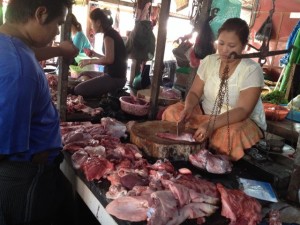Although reliable numbers are hard to come by, Myanmar pig production is expected to grow rapidly over the coming decades.
Livestock intensification
 This growth is being accompanied by an intensification of both pig production (the backyards and farms on which pigs are bred) and the pig supply-chain (the stages pigs pass through from farmer to the end-consumer). Such intensification is thought to affect the likelihood that bacterial zoonoses affect people.
This growth is being accompanied by an intensification of both pig production (the backyards and farms on which pigs are bred) and the pig supply-chain (the stages pigs pass through from farmer to the end-consumer). Such intensification is thought to affect the likelihood that bacterial zoonoses affect people.
The Myanmar Pig Partnership is investigating the effects of this intensification, along with other factors also thought to affect the likelihood of zoonotic infections passing between livestock and people. These include the increased use of antibiotics, the socioeconomic conditions of farmers, people’s understandings and practices, and the policy framework regulating pig production and public health in the country.
The Partnership is also concerned with how these changes affect the dynamics of antibiotic resistance, pig-specific diseases and productivity.
It is investigating in particular two bacterial zoonoses which are endemic to (i.e. regularly found in) pigs in Myanmar, Campylobacter and Salmonella enterica, and one which is emerging (i.e. increasing in incidence and likely to increase further), Streptococcus suis.
Risk environment & perception
One of the Partnership’s first tasks will be to characterise the different pig production systems in Myanmar and the risk environment, and to explore people’s perception of disease risk.
Overall research results will inform the design of integrated responses which will be implemented at the level of frontline workers in the supply chain and local communities, as well as at national and international levels.
- Read a ZELS case story ‘Researchers and pig farmers share practices to improve health and livelihoods in Myanmar’.
Back to main project page.